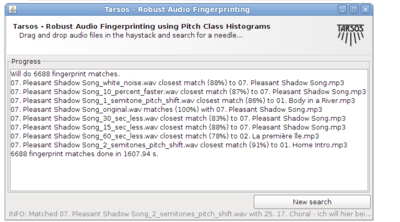~ A Robust Audio Fingerprinter Based on Pitch Class Histograms - Applications for Ethnic Music Archives
» By Joren on Tuesday 17 January 2012For the Folk Music Analyisis (FMA) 2012 conference we (Olmo Cornelis and myself), wrote a paper presenting a new acoustic fingerprint scheme based on pitch class histograms.
The aim of acoustic fingerprinting is to generate a small representation of an audio signal that can be used to identify or recognize similar audio samples in a large audio set. A robust fingerprint generates similar fingerprints for perceptually similar audio signals. A piece of music with a bit of noise added should generate an almost identical fingerprint as the original. The use cases for audio fingerprinting or acoustic fingerprinting are myriad: detection of duplicates, identifying songs, recognizing copyrighted material,…
Using a pitch class histogram as a fingerprint seems like a good idea: it is unique for a song and it is reasonably robust to changes of the underlying audio (length, tempo, pitch, noise). The idea has probably been found a couple of times independently, but there is also a reference to it in the literature, by Tzanetakis, 2003: Pitch Histograms in Audio and Symbolic Music Information Retrieval:
Although mainly designed for genre classification it is possible that features derived from Pitch Histograms might also be applicable to the problem of content-based audio identification or audio fingerprinting (for an example of such a system see (Allamanche et al., 2001)). We are planning to explore this possibility in the future.
Unfortunately they never, as far as I know, did explore this possibility, and I also do not know if anybody else did. I found it worthwhile to implement a fingerprinting scheme on top of the Tarsos software foundation. Most elements are already available in the Tarsos API: a way to detect pitch, construct a pitch class histogram, correlate pitch class histograms with a pitch shift,… I created a GUI application which is presented here. It is, probably, acoustic / audio fingerprinting system based on pitch class histograms.
It works using drag and drop and the idea is to find a needle (an audio file) in a hay stack (a large amount of audio files). For every audio file in the haystack and for the needle pitch is detected using an optimized, for speed, MPM implementation. A pitch class histogram is created for each file, the histogram for the needle is compared with each histogram in the hay stack and, hopefully, the needle is found in the hay stack.
An experiment was done on the audio collection of the museum for Central Africa. A test dataset was generated using SoX with the following Ruby script. The raw results were parsed with another Ruby script. With the data a spreadsheet with the results was created (OpenOffice.org format). Those results are mentioned in the paper.
You can try the system yourself by downloading the fingerprinter.


